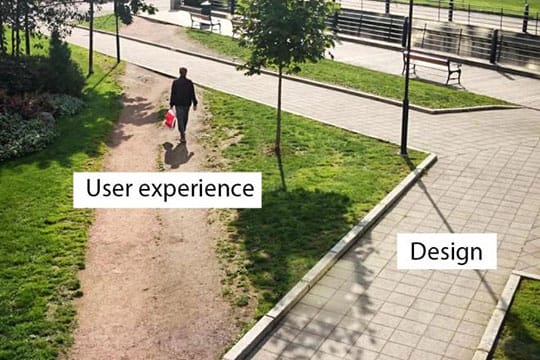“Logic will take you from A to B. Imagination will take you everywhere.” – Albert Einstein
Tom Hulme, the formerly design director at IDEO, during his speech at TED on “What Walkways Teach Us About Design”, stated that it is possible to evaluate the design decision only after seeing its use in real life. In this sense, the main focus should be on the empathy to users and not the beauty of the idea. Any theoretical decision could look folded on the paper, but in order to understand what users really want, it is better to invite them to make and follow their own choice.
I think that most of you are familiar with this image:

Source: https://guycookson.com
It clearly shows the difference between design and user experience. While the design is more focused on the look and the interactivity of the product, the UX stands for a human-first approach in designing products.
What is the Peculiarity of Design Thinking?
Tim Brown, CEO, and President of IDEO gives the following definition:
“Design thinking can be described as a discipline that uses the designer’s sensibility and methods to match people’s needs with what is technologically feasible and what a viable business strategy can convert into customer value and market opportunity”.
Design thinking helps to discover and understand why end-users do certain things and what they expect from the goods and services they buy. Such approach guarantees that the results of the project will meet all the expectations and demands of consumers.
Design thinking can be implemented through:
- the process of accumulating ideas
- thinking outside the box
- taking risky decisions
- deep understanding of consumers (their goals, behavior, and preferences)
- eliminating the fear of failure
- testing ideas to get a quick feedback from consumers
Every designer is familiar with the four stages of design thinking process: empathize, define, ideate, prototype, and test. This whole process is implied to be cyclical.
When I was conducting a research on how design thinking influence companies, I came across a lot of case studies and articles on how companies managed to succeed in introducing design thinking. I came to the conclusion that when companies scale and sustain design empathy, they are able to reach a wider audience and are more likely to connect with people in meaningful ways.
A solid and careful empathic research unlocks the door to creativity and understanding the consumers thus can serve as a key to innovation.
Empathy drives connection, and it’s the best way to feel what others feel.
If design empathy takes place in an organization, it should be throughout the organization. People should learn to tell stories from the empathic point of view.

Source: http://3pregnantdads.com/
Recommended for you: 5 Tips to Improve the UX (User Experience) of your eCommerce Website.
The Importance of Empathy
As a design thinker, you are trying to solve the problems of a group of people. To do so, it’s important to gain empathy for them.
When applying empathy, companies can get a deep emotional understanding of what people really need and what kind of modern challenges do they face. Observing and listening what people do and say gives an answer to what they really feel, think, and want.
Empathy is the first stage of the Design Thinking process, and the main goal here is to understand the people you are designing for. It includes engagement with the people and your (as a designer) intention to help them. In order for a designer to become empathic, it’s important to put aside one’s ego and try to understand what others feel. Being a good listener is another characteristic of empathy. It might sound trivial, but being able to listen to other voices and let others talk can be a good push to new solutions. Observe, be curious and try to uncover new insights on what people need.
One of the best examples of how empathy helped a business grow from a startup to a billion-dollar company is Airbnb.
How Empathy Saved AIRBNB?
Design thinking helps many companies to transform the way they manage their business. One of the most vivid examples is Airbnb. Using creative problem solving, one of the founders Joe Gebbia decided to change the course of the business. In 2009 Airbnb has almost gone bankrupt. He realized that the problem was that people couldn’t book rooms because they were not able to see the pictures. The quality was poor and not always corresponding with what was in reality.
At that time, Airbnb founders decided to take a camera and photograph the houses of the customers. What they did had they put themselves in their customers’ shoes, and this approach helped them to find out what travelers needed. By communicating with their customers and getting into their heads, they got the right answer. Following the principle of empathy, the guys from Airbnb got the right answer, which later helped them to grow into a million dollar business.
You may also like: 5 Tips to Design High Performance Mobile User Experiences.
Conclusion

Becoming a design-driven company is not something that happens suddenly. In order to be a design-oriented, a company should overcome a process of transformation. Paying attention to the users’ feelings toward a product is the best way to bolster innovation. Start with an emphatic research, make it your core competence. Your colleagues, friends, clients can help you look at things from different perspectives. As design thinkers, take a “people first” approach, carefully observe the world, and use the insights to inspire innovation.
This article is written by Kate Kucherenko. She is a content specialist at Agilie. She is passionate about writing and technology. Kate earned her master’s degree in English Philology from the University of Social Sciences and Humanities in Warsaw, Poland. Follow her: Facebook | Twitter | LinkedIn.





